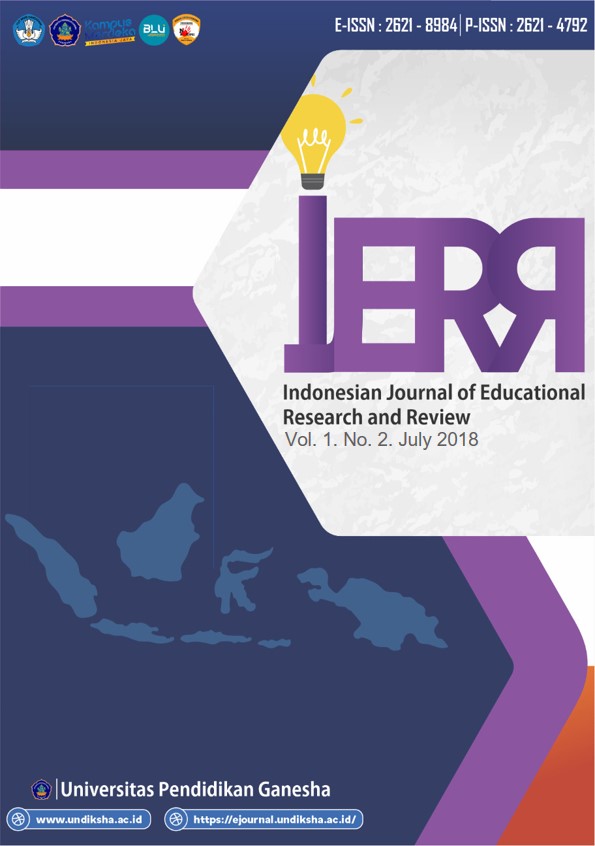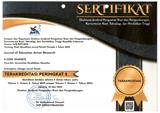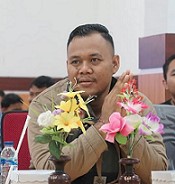HUBUNGAN POWER OTOT LENGAN DAN KOORDINASI MATA-TANGAN DENGAN HASIL SERVIS PANJANG DALAM PERMAIAN BULU TANGKIS PADA SISWA EXTRAKURIKULER SMA NEGERI 2 OKU
DOI:
https://doi.org/10.23887/ijerr.v1i2.15533Abstrak
The purpose of this study was to determine the relationship between muscle strength and eye-hand with the results in badminton games on extracurricular students of OKU 2 State Senior High School. The research method used is a correlational method which aims to determine the relationship between variables. The population in this study were 20 students who participated in badminton extracurricular activities at SMA Negeri 2 OKU, while the total sampling sample of this Research City had a sample of 20 students. The test instruments used were two-handed ball tests, ball catching tests and long service tests. Data analysis techniques used are moment and double product modifications.The results of the study prove that there is a relationship between strength and unit, which is proven by 0.716 based on interpretation interpretation tables that have very strong relationships. There is a relationship between responsibility and long service, as evidenced by as much as 0.512 based on the interpretation table interpretation of medium expression. There are strength and mental relationships that work together with long service, as evidenced by the coefficient of a large number of 0.736 based on the interpretation interpretation table must have a very strongReferensi
Arikunto Suharsimi, 2010. Prosedur Penelitian Suatu Praktik, Jakarta : PT , Rineka Cipta.
Fitrek Hernado, Soekardi, Wahyu Lestari. 2017. Pengaruh Metode Latihan dan PowerOtot Lengan terhadap Hasil Tolak Peluru. Journal of Physical Education and Sports Uness. Volume 6, Nomor 1. (p) 22-28.
Ghon Lisdiantoro. 2016. Hubungan antara Koordinasi Mata Tangan, Power Otot Lengan dan Kekuatan Otot Perut dengan Kemampuan Pukulan Smash dalam Permainan Bulutangkis Premiere Educandum IKIP PGRI Madiun. Volume 6 Nomor 2. (p) 210 – 221.
Helda Heldayana, Aming Supriyatna, Iman Imanudin. 2016. Hubungan Antara Power Otot Lengan Dan Otot Tungkai Dengan Hasil Spike Semi Pada Cabang Olahraga Bola Voli. Jurnal Terapan Ilmu Keolahragaan. Vol.01 No.01. (p) 45-49.
Heri Yogo Prayadi, Hari Amirullah Rachman. 2013. Pengaruh Metode Latihan dan Power Lengan terhadap Kemampuan Smash Bulutangkis. Jurnal Keolahragaan UNY, Volume 1 Nomor 1.
Ismaryati, 2011. Tes & Pengukuran Olahraga, Lembaga Pengembang Pendidikan (LPP) UNS dan UNS Press: Surakarta.
Maulidin. 2017. Hubungan Power Otot Lengan Dan Kekuatan Genggaman Dengan Hasil Servis Slice Pada Permainan Tenis Lapangan Pada Mahasiswa FPOK IKIP Mataram Tahun 2017. Jurnal Ilmiah Mandala Education (JIME). Vol 3, Nomor 1.
Muhajir. 2005. Pendidikan Jasmani Teori dan Praktek. Erlangga: Jakarta.
Muharam Syuhada. 2013. Hubungan Antara Power Otot Lengan Bahu, Kekuatan Otot Tungkai, Koordinasi Mata Tangan dengan Kemampuan Free Throw Pada Peserta Ekstrakurikuler Bolabasket di SMA N 1 Ngemplak Sleman. Jurnal Keolahragaan UNY. Volume 3 nomor 2.
Nurhasan, 2001. Tes dan Pengukuran dalam Pendidikan Jasmani. Jakarta; Direktorat Jenderal Olahraga.
Poole, James. 2011. Belajar Bulu Tangkis. Bandung: CV. Pionir Jaya.
Sugiyono. 2011. Metode Penelitian Kuantitatif Kulitatif dan R&D. Bandung: ALFABETA.
Widiastuti.2011. Tes dan Pengukuran Olahraga. Jakarta : PT Bumi Timur Jaya
Winarno. 2011. Metodologi Penelitian Dalam Pendidikan Jasmani. Malang: Media Cakrawala Utama Press.
Unduhan
Diterbitkan
Cara Mengutip
Terbitan
Bagian
Lisensi
Authors who publish with the Indonesian Journal of Educational Research and Review (IJERR) agree to the following terms:
- Authors retain copyright and grant the journal the right of first publication with the work simultaneously licensed under a Creative Commons Attribution License (CC BY-SA 4.0) that allows others to share the work with an acknowledgment of the work's authorship and initial publication in this journal.
- Authors are able to enter into separate, additional contractual arrangements for the non-exclusive distribution of the journal's published version of the work (e.g., post it to an institutional repository or publish it in a book), with an acknowledgment of its initial publication in this journal.
- Authors are permitted and encouraged to post their work online (e.g., in institutional repositories or on their website) prior to and during the submission process, as it can lead to productive exchanges, as well as earlier and greater citation of published work. (See The Effect of Open Access)












